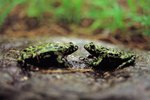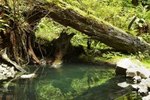
The platypus is a highly unusual animal for a number of reasons. It is one of only two mammals to lay eggs (the other being the echidna), it is one of only two species of mammal capable of envenomating (the other being the shrew) and it has a beak. It is highly adapted in a number of other ways, too, and is truly a strange product of its environment.
Egg Laying
Egg laying mammals are called monotremes, and there are only five species that do so -- four of which are echidna. Little fossil evidence of monotremes exists, but scientists believe that before evolving to deliver live young, most mammals laid eggs. In that regard, the platypus is a historic relic.
Poison Spur
In contrast to its lack of evolution on the egg-laying front, platypus are highly evolved in other areas. Male platypodes have a spur on each foot, from which they can deliver a venomous sting. This capacity to deliver poison is extremely rare for mammals. Shrews are capable of doing it, too, but the platypus is the only creature on Earth to have a venomous spur.
Duck Bill
One of the most distinguishing feature of the platypus is its duck bill. This feature enable the platypus to hear and breathe while diving for prey. It is remarkably similar to a duck’s bill, hence the name, but it most likely evolved independently of the duck, despite this similarity.
Strong Claws
As well as being good at swimming, platypodes are good diggers. They have adapted to have strong, shovel-like claws that enable them to move and disturb thick, heavy soil and mud. They dig in order to burrow. This is especially important for females, who use a nesting burrow for raising their young.
Fat Tail
The platypus tail is fat and flat. Its flatness assists with swimming, functioning almost like a rudder. But the tail is also a fat store. Again, this adaptation is especially important for females, who require stores of fat for nesting in their burrow. However, males store fat as well, for periods when they are unable to find food.
Webbed Feet
Platypuses have evolved to have webbed feet. The webs enable them to swim more efficiently and move around on soft, muddy surfaces with ease. The front feet are fully webbed, the hind feet are only partially webbed.
References
Photo Credits
-
mlauri/iStock/Getty Images
Writer Bio
Simon Foden has been a freelance writer and editor since 1999. He began his writing career after graduating with a Bachelors of Arts degree in music from Salford University. He has contributed to and written for various magazines including "K9 Magazine" and "Pet Friendly Magazine." He has also written for Dogmagazine.net.




